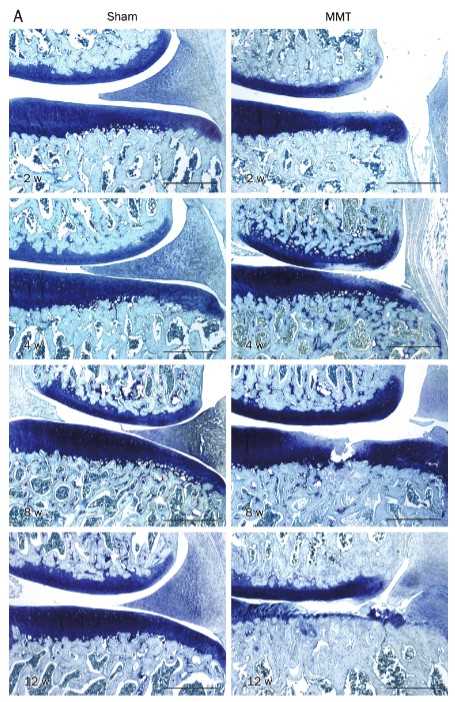Medial Meniscal Tear (MMT)-Induced Osteoarthritis (OA) Model
As one of the most well-recognized experts in the field of osteoarthritis (OA) research, Creative Bioarray takes pride in delivering exceptional services tailored to our clients' needs. We specialize in the development and optimization of OA models, and one of our key services is the establishment of a stable OA model induced by medial meniscal tear (MMT). By leveraging this model, we can help you gain a deeper understanding of OA or evaluate the efficacy of your drug candidates.
Osteoarthritis, a degenerative disease that gradually worsens over time, is often accompanied by chronic pain, significantly affecting patients' quality of life. Characterized as a chronic, progressive, and multifactorial condition, OA leads to a steady decline in the structure and function of articular cartilage, primarily affecting middle-aged and older individuals. Given the escalating incidence of this condition, there has been a surge in the utilization of animal models as a crucial tool to enhance our understanding of OA pathogenesis and to explore potential therapeutic options throughout various stages of disease progression. Over the years, the medial meniscal tear (MMT) model has proven to be an extensively utilized platform for assessing the efficacy of potential anti-arthritic agents and evaluating the disease-modifying effects of various treatments.
Our Medial Meniscal Tear (MMT)-Induced Osteoarthritis (OA) Model
- Available Animal
Rat - Modeling Method
Rats are anesthetized and the right knee area is prepared for surgery. The medial collateral ligament of the right knee is transected, and the medial meniscus is reflected proximally toward the femur and cut through at its narrowest point. - Endpoints
- Body weight
- Behavioral tests
- Histology analysis (knee joint): H&E staining, Toluidine blue staining
- Cytokine analysis
- Other customized endpoints
Example Data
 Fig. 1 Changes in articular cartilage during OA progression. (A) Representative images with toluidine blue O staining.
Fig. 1 Changes in articular cartilage during OA progression. (A) Representative images with toluidine blue O staining.
In addition, we also provide other OA models that maybe you are interested in:
- Monosodium Iodoacetate (MIA)-Induced Osteoarthritis (OA) Model
- Papain-Induced Osteoarthritis (OA) Model
- Anterior Cruciate Ligament Transection (ACLT)-Induced Osteoarthritis (OA) Model
Quotation and Ordering
Creative Bioarray, a leading CRO partner, offers world-class services in the realm of in vivo efficacy studies. If you are interested in our services, please do not hesitate to contact us at any time or submit an inquiry to us directly. We look forward to cooperating with you.
Reference
- Yu, D., et al. Efficacy of zoledronic acid in treatment of teoarthritis is dependent on the disease progression stage in rat medial meniscal tear model. Acta pharmacologica Sinica, 2012, 33(7): 924-934.
For research use only. Not for any other purpose.
Disease Models
- Oncology Models
-
Inflammation & Autoimmune Disease Models
- Rheumatoid Arthritis Models
- Glomerulonephritis Models
- Multiple Sclerosis (MS) Models
- Ocular Inflammation Models
- Sjögren's Syndrome Model
- LPS-induced Acute Lung Injury Model
- Peritonitis Models
- Passive Cutaneous Anaphylaxis Model
- Delayed-Type Hypersensitivity (DTH) Models
- Inflammatory Bowel Disease Models
- Systemic Lupus Erythematosus Animal Models
- Oral Mucositis Model
- Asthma Model
- Sepsis Model
- Psoriasis Model
- Atopic Dermatitis (AD) Model
- Scleroderma Model
- Gouty Arthritis Model
- Carrageenan-Induced Air Pouch Synovitis Model
- Carrageenan-Induced Paw Edema Model
- Experimental Autoimmune Myasthenia Gravis (EAMG) Model
- Graft-versus-host Disease (GvHD) Models
-
Cardiovascular Disease Models
- Surgical Models
- Animal Models of Hypertension
- Venous Thrombosis Model
- Atherosclerosis model
- Cardiac Arrhythmia Model
- Hyperlipoidemia Model
- Doxorubicin-induced Heart Failure Model
- Isoproterenol-induced Heart Failure Model
- Arterial Thrombosis Model
- Pulmonary Arterial Hypertension (PAH) Models
- Heart Failure with Preserved Ejection Fraction (HFpEF) Model
-
Neurological Disease Models
- Alzheimer's Disease Modeling and Assays
- Seizure Models
- Parkinson's Disease Models
- Ischemic Stroke Models
- Acute Spinal Cord Injury (ASCI) Model
- Traumatic Brain Injury (TBI) Model
- Hypoxic-Ischemic Encephalopathy (HIE) Model
- Tourette Syndrome (TS) Model
- Amyotrophic Lateral Sclerosis (ALS) Model
- Huntington's Disease (HD) Model
- Intracerebral hemorrhage (ICH) Models
- Schizophrenia Model
- Pain Models
-
Metabolic Disease Models
- Type 1 Diabetes Mellitus Model
- Type 2 Diabetes Mellitus Model
- Animal Model of Hyperuricemia
-
Nonalcoholic Fatty Liver Disease Model
- High-Fat Diet-Induced Nonalcoholic Fatty Liver Disease (NAFLD) Model
- Methionine and Choline Deficient (MCD) Diet-Induced Nonalcoholic Fatty Liver Disease (NAFLD) Model
- Gubra-Amylin NASH (GAN) Diet-Induced Nonalcoholic Fatty Liver Disease (NAFLD) Model
- Streptozotocin (STZ) Induced Nonalcoholic Fatty Liver Disease (NAFLD) Model
- High Fat Diet-Induced Obesity Model
- Diabetic Foot Ulcer (DFU) Model
- Liver Disease Models
- Rare Disease Models
- Respiratory Disease Models
- Digestive Disease Models
-
Urology Disease Models
- Cisplatin-induced Nephrotoxicity Model
- Unilateral Ureteral Obstruction Model
- 5/6 Nephrectomy Model
- Renal Ischemia-Reperfusion Injury (RIRI) Model
- Diabetic Nephropathy (DN) Models
- Passive Heymann Nephritis (PHN) Model
- Adenine-Induced Chronic Kidney Disease (CKD) Model
- Kidney Stone Model
- Doxorubicin-Induced Nephropathy Model
- Orthotopic Kidney Transplantation Model
- Orthopedic Disease Models
- Ocular Disease Models
- Skin Disease Models
- Infectious Disease Models
- Otology Disease Models